This post may contain affiliate links. Please read our disclosure policy.
Bánh bò nướng, also known as honeycomb cake, is a classic Vietnamese sweet snack that is soft, chewy, and so delicious! Our version features chewy golden brown coconut pancakes filled with freshly grated coconut meat!
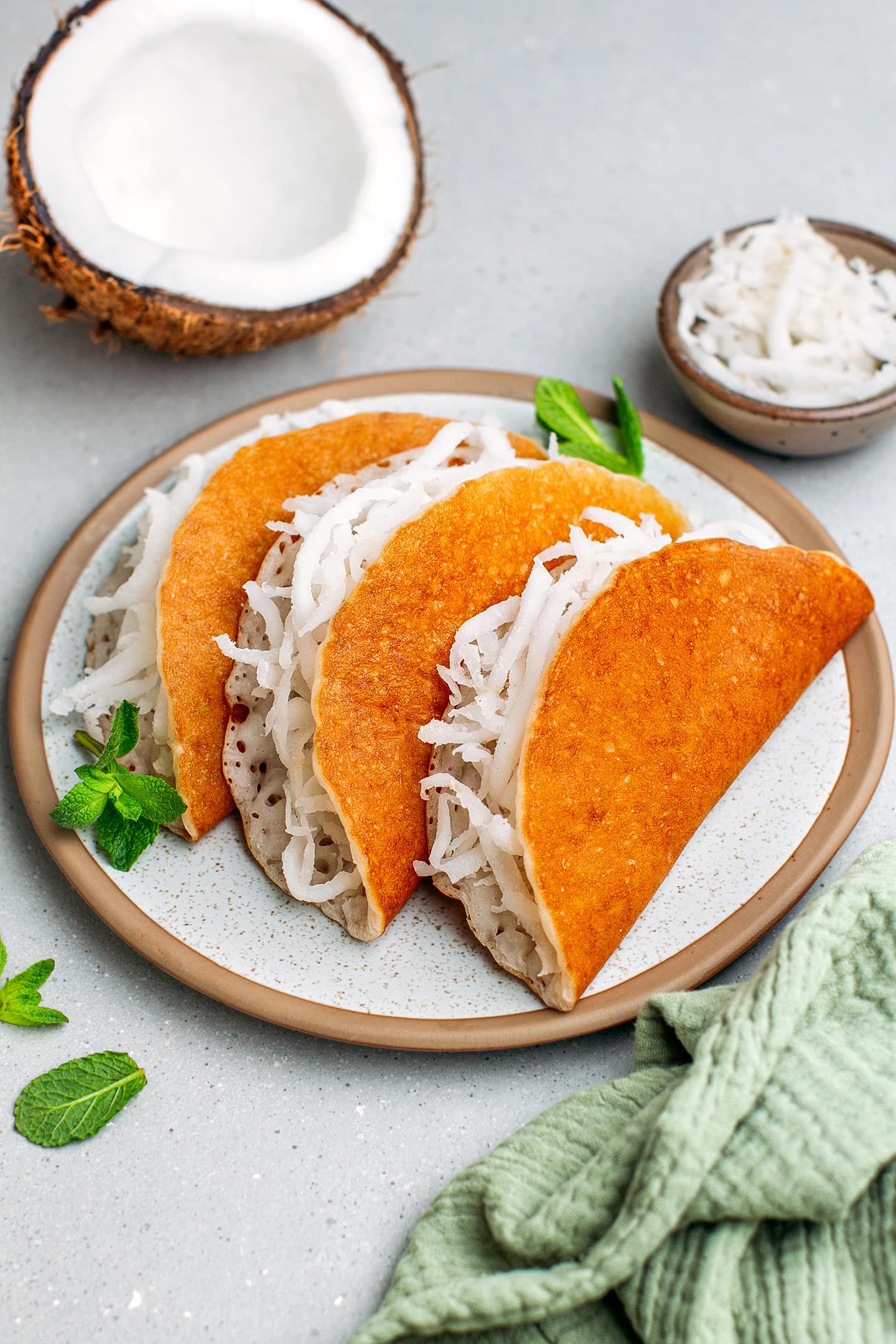
⭐️ Why You Should Try It
- Crispy and chewy. This bánh bò nướng is crispy on the edges, slightly chewy on the inside (a bit like mochi), and filled with sweet and crispy grated coconut. We personally love the contrast of the chewy pancakes with the crispy filling!
- Sweet and coconutty. Coconut lovers, you will love these cute Vietnamese pancakes! They are perfectly sweet and pack a ton of coconut flavor that comes from both coconut milk and fresh coconut meat. Plus, they are naturally gluten-free and vegan!
- Simple and fun to prepare. If you have ever made pancakes before, you will feel right at home with this recipe, as the process is basically the same. It consists of preparing the pancake batter, making the coconut filling, cooking the pancakes, and then filling them with the coconut mixture.
📘 What is Bánh Bò Nướng
Bánh bò, also known as honeycomb cake, is a sweet Vietnamese cake made of rice flour, tapioca starch, coconut milk, sugar, and yeast. It has a spongy and chewy texture and a characteristic porous texture, resembling a honeycomb. There are many different versions of this cake, including a popular one that includes pandan extract, which gives the cake a vibrant green color and a floral aroma.
This version is a twist on the original, as the batter is not baked or cooked into a large cake, but into thin pancakes on a skillet and filled with freshly shredded coconut. It’s our favorite version, and we like it even more than the classic!
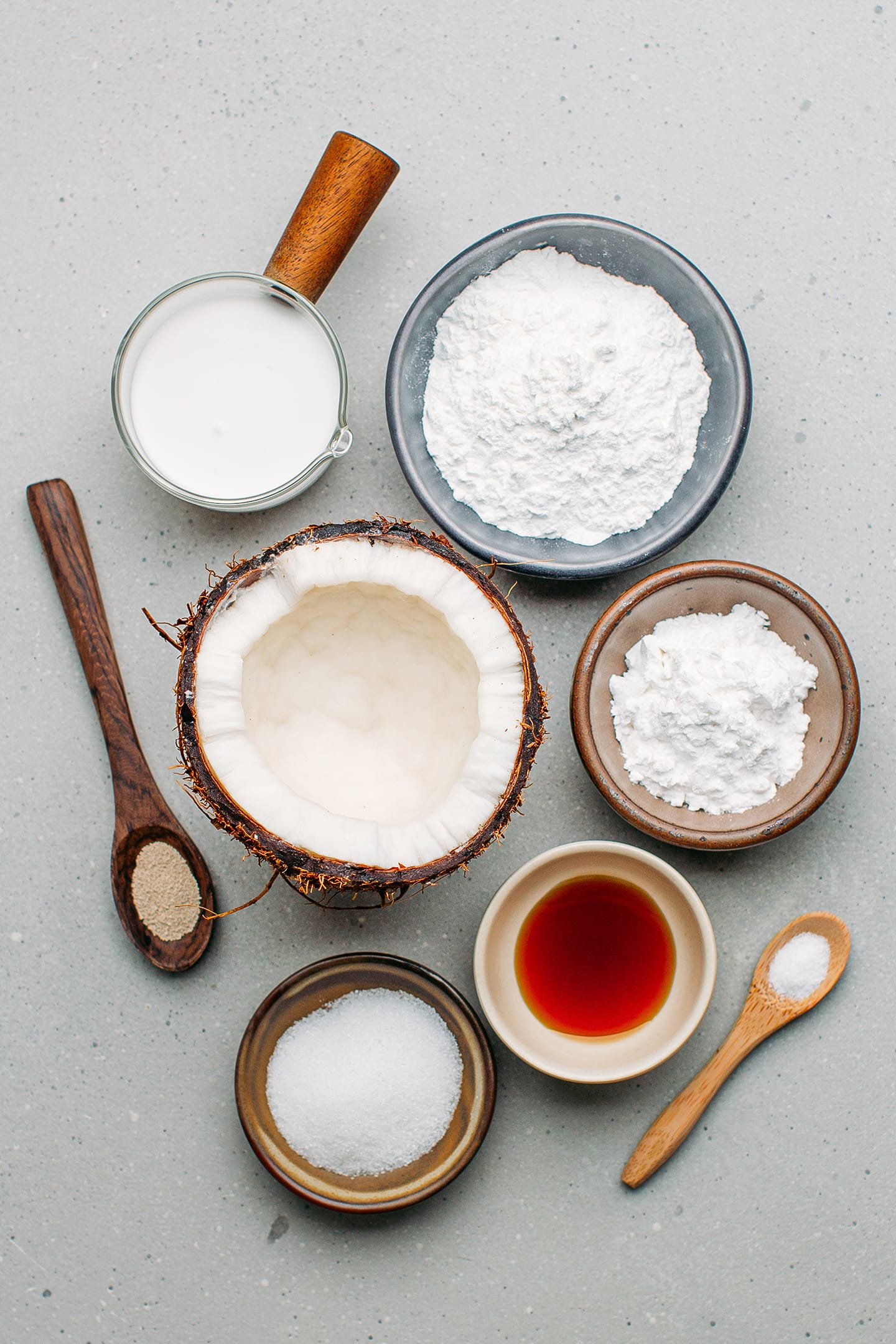
🥥 Ingredient Notes
Here is what you will need to make these Vietnamese pancakes:
- Rice flour – Use regular white rice flour. Do not use sweet/glutinous rice flour, as it won’t work for this recipe.
- Tapioca starch – Adding tapioca starch to the batter helps create a chewy and stretchy texture. It also prevents the pancakes from falling apart as the batter does not contain any gluten or any other binder.
- Sugar – Use granulated white sugar. Light brown or coconut sugar would also work, but they would alter the color and texture of the batter.
- Instant yeast – To make the pancakes rise.
- Baking powder – In addition to instant yeast, we will use baking powder to create an even more aerated texture.
- Coconut milk – Preferably full-fat coconut milk. It is responsible for adding richness and a ton of coconut flavor. Note: If you prefer to use light coconut milk, you will have to slightly grease your pan while cooking the pancakes.
- Vanilla – Optional but recommended. Vanilla extract adds a fresh and floral aroma to the pancakes.
- Fresh coconut – To prepare the shredded coconut filling, you will need the flesh of one fresh coconut. For best results, select a coconut that feels heavy, which indicates that it’s full of water. You can also check the eyes of the coconut. They should feel firm to the touch and show no signs of mold.
🥣 How to Make It
1. Prepare the coconut filling
- Drain the water. First, drain the coconut water from the coconut. To do so, poke two holes in the eyes of the coconut. You can use a screwdriver or a metal spike for this step. Place the screwdriver on one of the eyes and hit it with a hammer until it pierces the coconut. Then, drain the coconut water over a glass or bowl.
- Open the coconut. Next, to crack open the coconut, use a hammer to firmly strike it in the middle, rotating it as you go. After 7-10 hits, the coconut should crack, and you will be able to open it in half. You can check this video on how to open a coconut with a hammer if you want to see the process.
- Grate it. Using a coconut grater, grate the coconut flesh to make long strips. You should end up with about 2 cups of shredded coconut.
Note: Feel free to grate the coconut into thinner or thicker strips. That is totally up to you, and it won’t affect the end result. Thicker strips will bring more chew and crispiness, while thinner strips will give the filling a meatier texture.
- Coat it with sugar. Transfer the shredded coconut to a bowl and sprinkle with the sugar. Toss to coat and let it sit for 10-15 minutes.
- Cook it in a pan. Then, transfer the shredded coconut to a pan and cook it over medium heat for 5-7 minutes, stirring regularly, until it is no longer moist. Do not cook it for too long, you do not want to toast it. Cook it just long enough to just remove the moisture and melt the sugar.
- Set aside. Remove from heat and set the shredded coconut aside.
2. Make the batter
- Whisk together the dry ingredients. Add the rice flour, tapioca starch, sugar, instant yeast, baking powder, and salt to a mixing bowl. Whisk until combined.
- Add the wet ingredients. Next, pour in the coconut milk, water, and vanilla extract. Whisk until smooth.
- Make the rice flour paste. To prevent the rice flour from separating from the water, we will cook a rice paste. It will help emulsify and bind the batter. To do so, add the rice flour and water to a saucepan. Whisk to dissolve the flour. Heat over medium heat, whisking constantly until the mixture forms a paste. Remove from the heat and allow the rice paste to cool for about 5 minutes.
- Stir the paste into the batter. Once the paste has cooled a bit, transfer it to the batter and whisk until fully combined.
- Let the batter rest. Cover the bowl with plastic wrap and let it rest for about 2 hours. The batter is ready when you can see a lot of bubbles forming on the surface.
3. Cook
- Heat a non-stick pan. It’s now time to cook the pancakes! Start by heating a non-stick pan over medium heat.
- Pour the batter. Once hot, pour about 1/2 cup of the batter onto the pan. The batter is quite thin, so it should spread into a pancake by itself. Your pancakes should have a diameter of about 4.5-inch (11cm). Cook uncovered for about 1 minute.
- Cover and steam. Next, cover the pan with a lid and steam the pancake for another 2-3 minutes or until the top looks no longer liquid.
- Fill the pancake with coconut. Remove the lid and top half of the pancake with a handful of shredded coconut. The amount you want to put is completely up to you.
- Fold it. Finally, use a spatula to lift half of the pancake and fold it into a half-moon shape. Transfer to a plate.
- Repeat. Repeat with the remaining batter and enjoy while still warm!
📔 Tips
- Pick a very fresh coconut. Ensure you are using a fresh coconut to make the shredded coconut filling. If the coconut flesh has a weird smell or a pink hue, do not use it.
- Adjust the sweetness to your liking. Our version of bánh bò nướng is less sweet than the ones you can find in Vietnam. However, if you don’t have a sweet tooth, you still might have to slightly decrease the amount of sugar in both the batter and the coconut filling.
- Let the batter rest. Do not omit this step, as it’s essential for the yeast to activate.
- Do not make the pancakes too small. We recommend using 1/3 to 1/2 cup of the batter for each pancake. If your pancakes are too small, you won’t be able to add enough filling, and they won’t stay folded.
- Cook over medium-high heat. You must absolutely cook the pancakes over medium or medium-high heat. If the pan is not hot enough, the pancakes will have some cracks and won’t be as airy.
- Fold the pancakes while still hot. Pancakes must be folded on the pan while they are still hot. Otherwise, they won’t hold their shape.
- Enjoy while still warm. These coconut pancakes are best served immediately after cooking, while they are warm and still slightly crispy on the edges. After a few hours, they tend to soften and won’t taste as good.
🌿 Variations
Here are a couple of ideas on how you can customize these pancakes:
- Add pandan extract: You can infuse the pancakes with about 1/4 teaspoon of pandan extract. It will add a subtle floral aroma and give your pancakes a vibrant green color.
- Garnish with peanuts: In addition to the grated coconut, feel free to fill them with a handful of slightly crushed roasted peanuts for extra crunch and nuttiness!
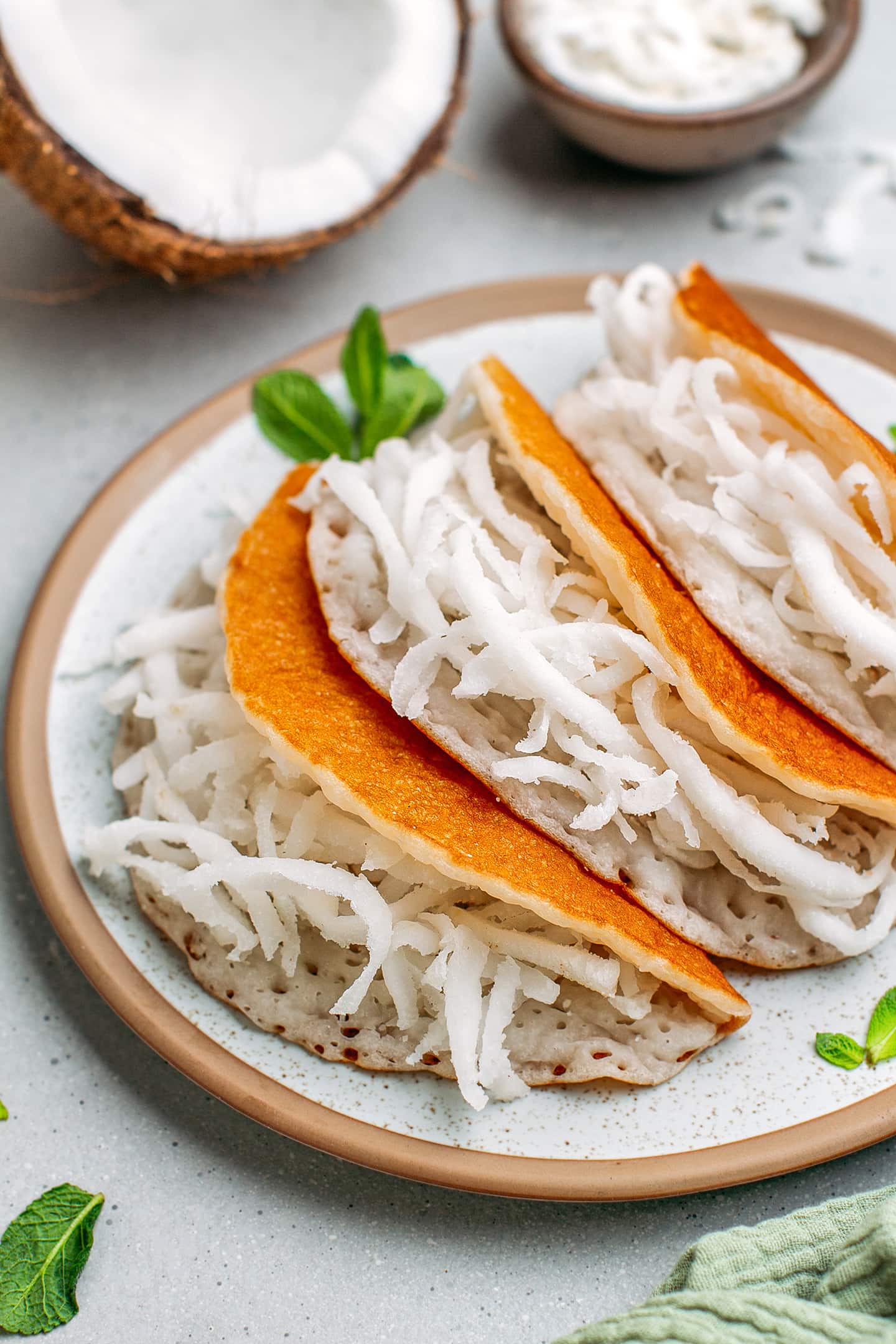
🍹 What to Serve It With
You can enjoy Bánh bò nướng as an afternoon pick-me-up snack with some fresh drink such as this peach, orange, and lemongrass iced tea or this creamy taro milk tea!
❄️ Storing and Reheating
- To store: You can keep these pancakes for up to 2 days in an airtight container at room temperature. Be aware that they taste best on day one.
- To reheat: Cover with aluminum foil and reheat for 5 minutes in a 350°F (175°C) preheated oven.

💬 FAQ
You can use shredded coconut, but it will alter the texture and flavor of these pancakes. Compared to freshly grated coconut, store-bought shredded coconut will be dryer and less flavorful.
There is no need to flip the pancakes. You should cook them on only one side.
First, the top middle should appear cooked (it shouldn’t be shiny but matte) and no longer be liquid. Second, the pancakes should be golden brown on the bottom. You can carefully lift them with a spatula to check the color.


Want to Save This Recipe?
Enter your email below & we’ll send it straight to your inbox! Plus, you will receive new recipes every week!
I’d like to receive more tips & recipes from Full of Plants.
This site is protected by reCAPTCHA and the Google Privacy Policy and Terms of Service apply.
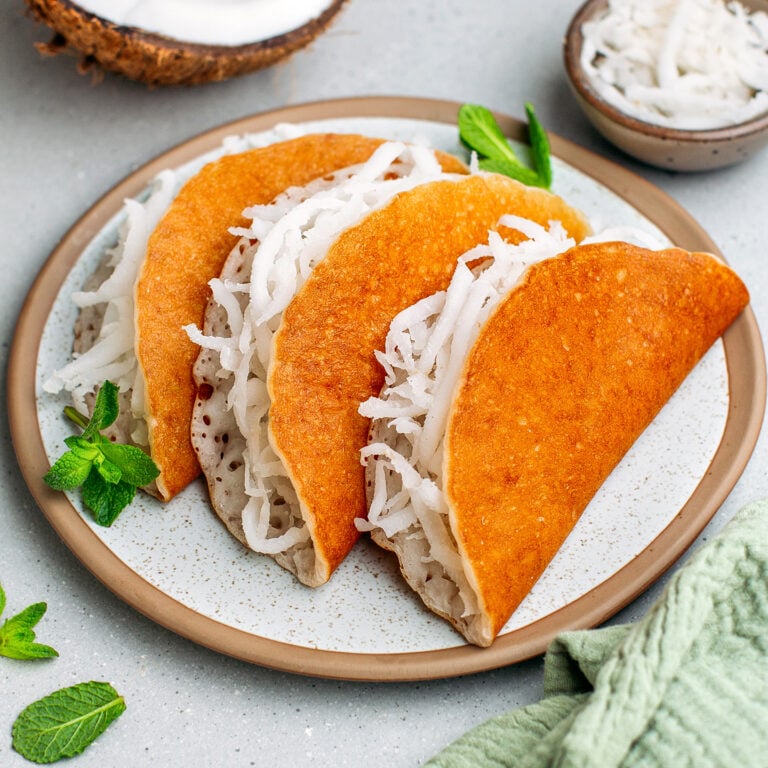
Banh Bo Nuong
Ingredients
Coconut Filling
- 1 medium fresh coconut
- 3 tbsp sugar
Pancake Batter
- 5 tbsp rice flour
- 6 tbsp tapioca flour
- 1/4 cup sugar
- 1/2 tsp instant yeast
- 1/2 tsp baking powder
- 1/8 tsp salt
- 1/4 cup full-fat coconut milk
- 1/4 cup water
- 1 tsp vanilla extract
Rice Flour Paste
- 1 tbsp rice flour
- 1/4 cup water
Instructions
Coconut Filling
- Drain the water. First, drain the coconut water from the coconut. To do so, poke two holes in the eyes of the coconut. You can use a screwdriver or a metal spike for this step. Place the screwdriver on one of the eyes and hit it with a hammer until it pierces the coconut. Then, drain the coconut water over a glass or bowl.
- Open the coconut. Next, to crack open the coconut, use a hammer to firmly strike it in the middle, rotating it as you go. After 7-10 hits, the coconut should crack, and you will be able to open it in half. You can check this video on how to open a coconut with a hammer if you want to see the process.
- Grate it. Using a coconut grater, grate the coconut flesh to make long strips. You should end up with about 2 cups of shredded coconut.
- Coat it with sugar. Transfer the shredded coconut to a bowl and sprinkle with the sugar. Toss to coat and let it sit for 10-15 minutes.
- Cook it in a pan. Then, transfer the shredded coconut to a pan and cook it over medium heat for 5-7 minutes, stirring regularly, until it is no longer moist. Do not cook it for too long, you do not want to toast it. Cook it just long enough to just remove the moisture and melt the sugar.
Pancake Batter
- Whisk together the dry ingredients. Add the rice flour, tapioca starch, sugar, instant yeast, baking powder, and salt to a mixing bowl. Whisk until combined.
- Add the wet ingredients. Next, pour in the coconut milk, water, and vanilla extract. Whisk until smooth.
- Make the rice flour paste. To prevent the rice flour from separating from the water, we will cook a rice paste. It will help emulsify and bind the batter. To do so, add the rice flour (1 tablespoon) and water to a saucepan. Whisk to dissolve the flour. Heat over medium heat, whisking constantly until the mixture forms a paste. Remove from the heat and allow the rice paste to cool for about 5 minutes.
- Stir the paste into the batter. Once the paste has cooled a bit, transfer it to the batter and whisk until fully combined.
- Let the batter rest. Cover the bowl with plastic wrap and let it rest for about 2 hours. The batter is ready when you can see a lot of bubbles forming on the surface.
Assemble
- Heat a non-stick pan. It’s now time to cook the pancakes! Start by heating a non-stick pan over medium heat.
- Pour the batter. Once hot, pour about 1/2 cup of the batter onto the pan. The batter is quite thin, so it should spread into a pancake by itself. Your pancakes should have a diameter of about 4.5-inch (11cm). Cook uncovered for about 1 minute.
- Cover and steam. Next, cover the pan with a lid and steam the pancake for another 2-3 minutes or until the top looks no longer liquid.
- Fill the pancake with coconut. Remove the lid and top half of the pancake with a handful of shredded coconut. The amount you want to put is completely up to you.
- Fold it. Finally, use a spatula to lift half of the pancake and fold it into a half-moon shape. Transfer to a plate.
- Repeat. Repeat with the remaining batter and enjoy while still warm!
- You can keep these pancakes for up to 2 days in an airtight container at room temperature. Be aware that they taste best on day one.
Notes
- Pick a very fresh coconut. Ensure you are using a fresh coconut to make the shredded coconut filling. If the coconut flesh has a weird smell or a pink hue, do not use it.
- Adjust the sweetness to your liking. Our version of bánh bò nướng is less sweet than the ones you can find in Vietnam. However, if you don’t have a sweet tooth, you still might have to slightly decrease the amount of sugar in both the batter and the coconut filling.
- Let the batter rest. Do not omit this step, as it’s essential for the yeast to activate.
- Do not make the pancakes too small. We recommend using 1/3 to 1/2 cup of the batter for each pancake. If your pancakes are too small, you won’t be able to add enough filling, and they won’t stay folded.
- Cook over medium-high heat. You must absolutely cook the pancakes over medium or medium-high heat. If the pan is not hot enough, the pancakes will have some cracks and won’t be as airy.
- Fold the pancakes while still hot. Pancakes must be folded on the pan while they are still hot. Otherwise, they won’t hold their shape.
- Enjoy while still warm. These coconut pancakes are best served immediately after cooking, while they are warm and still slightly crispy on the edges. After a few hours, they tend to soften and won’t taste as good.
Nutrition

About the Author
Thomas Pagot is the founder, photographer, and recipe developer behind Full of Plants. He created the blog in 2016 as a personal cookbook for vegan recipes. Through years of recipe development, Thomas has successfully grown Full of Plants into a trusted resource for plant-based recipes.

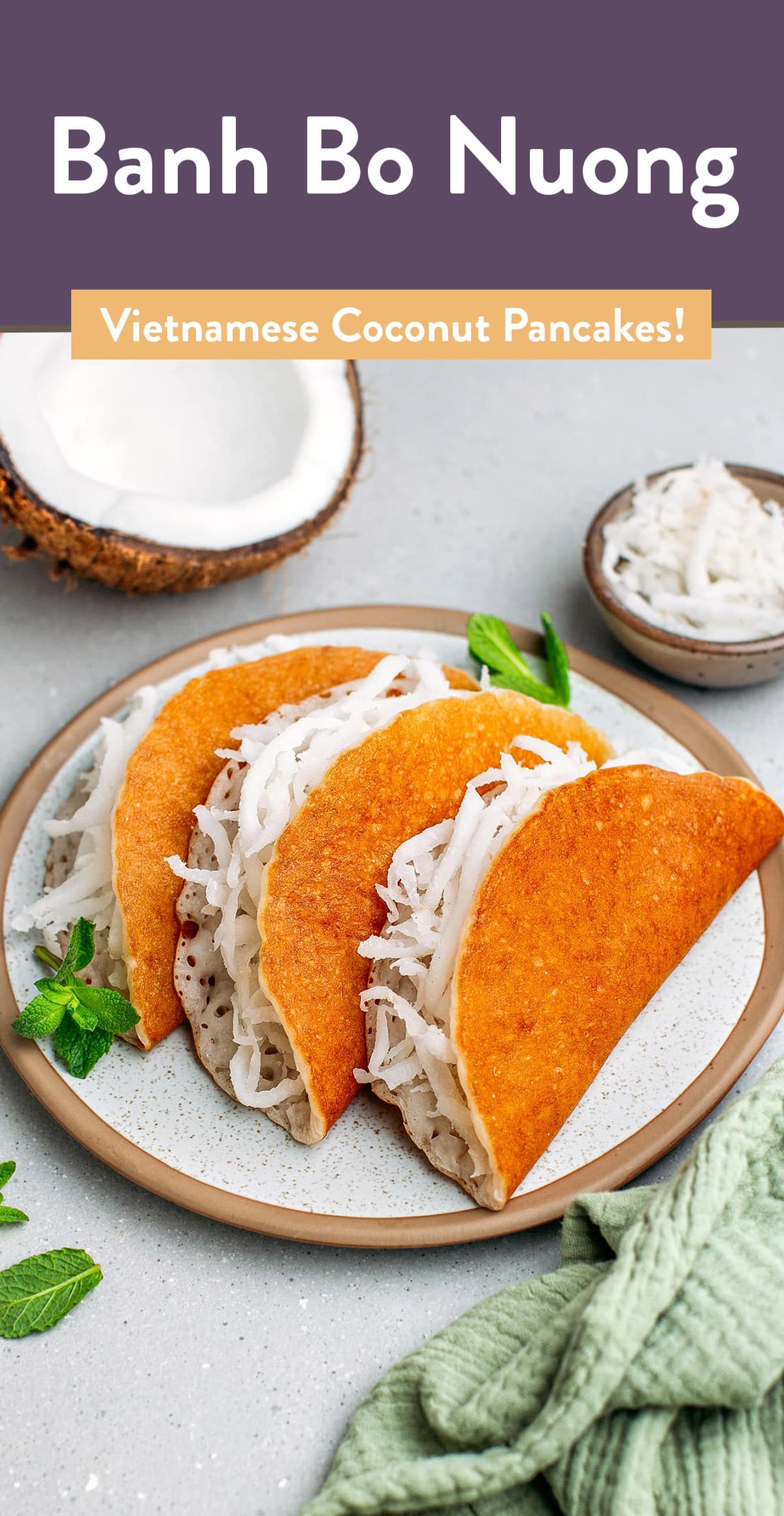
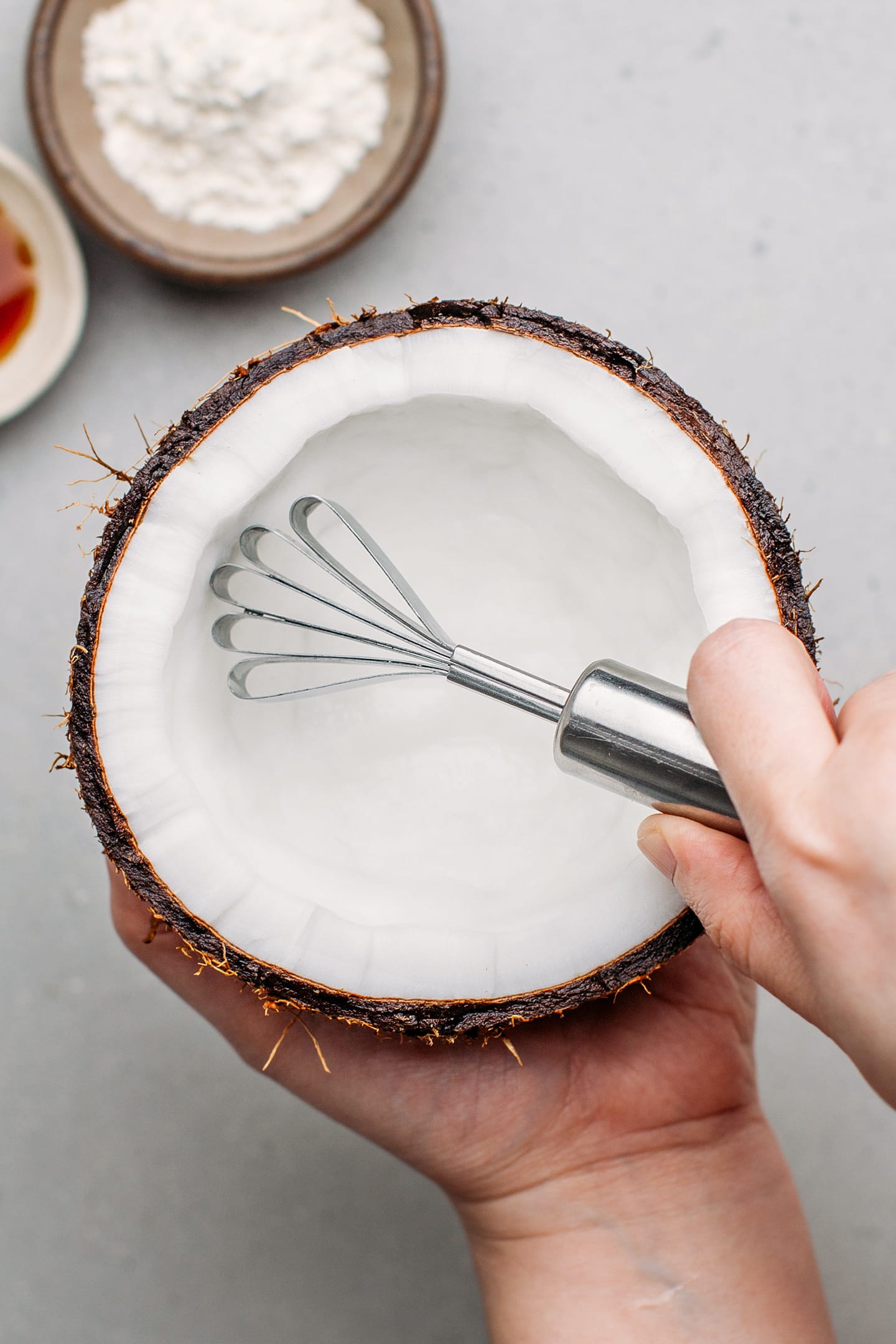
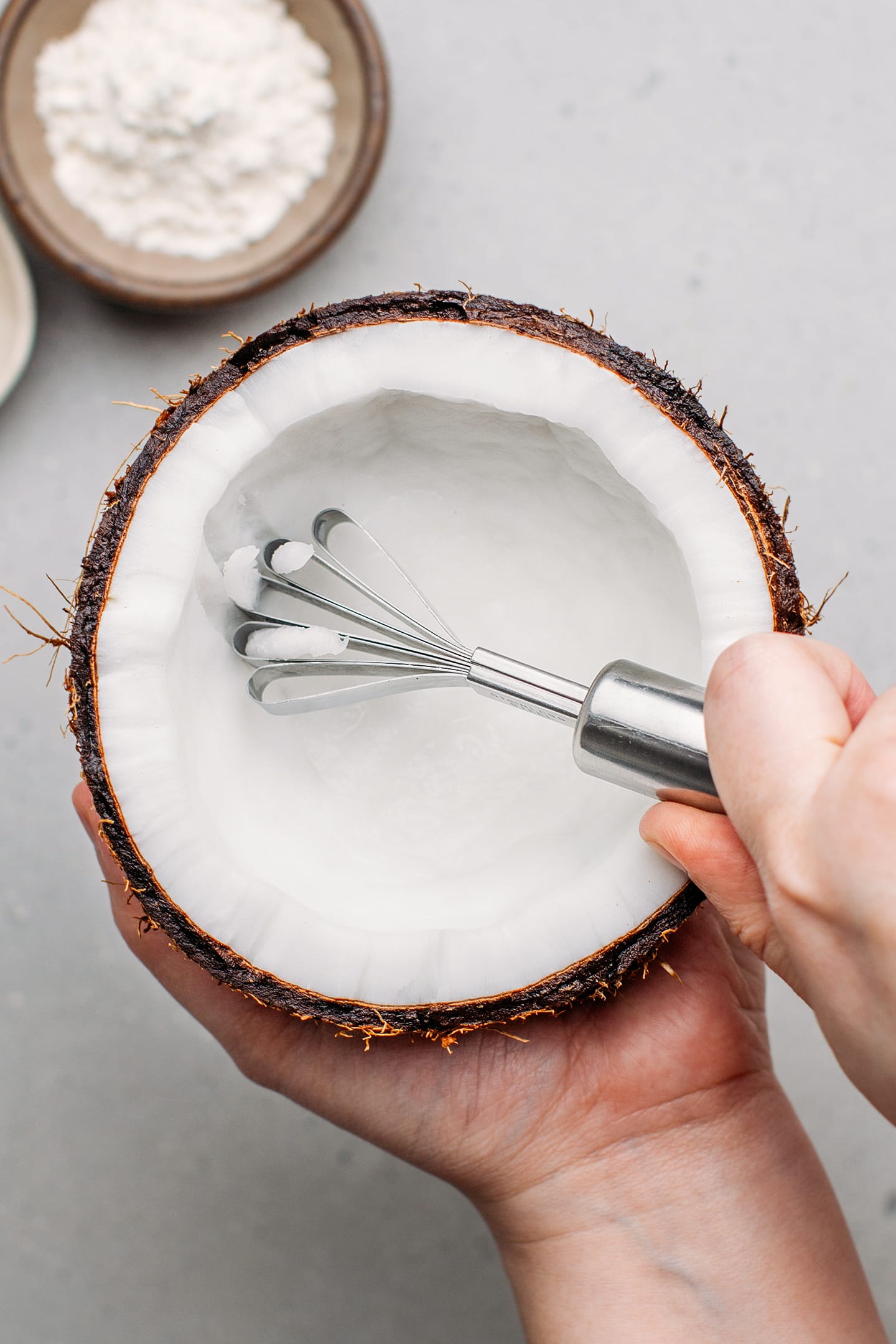

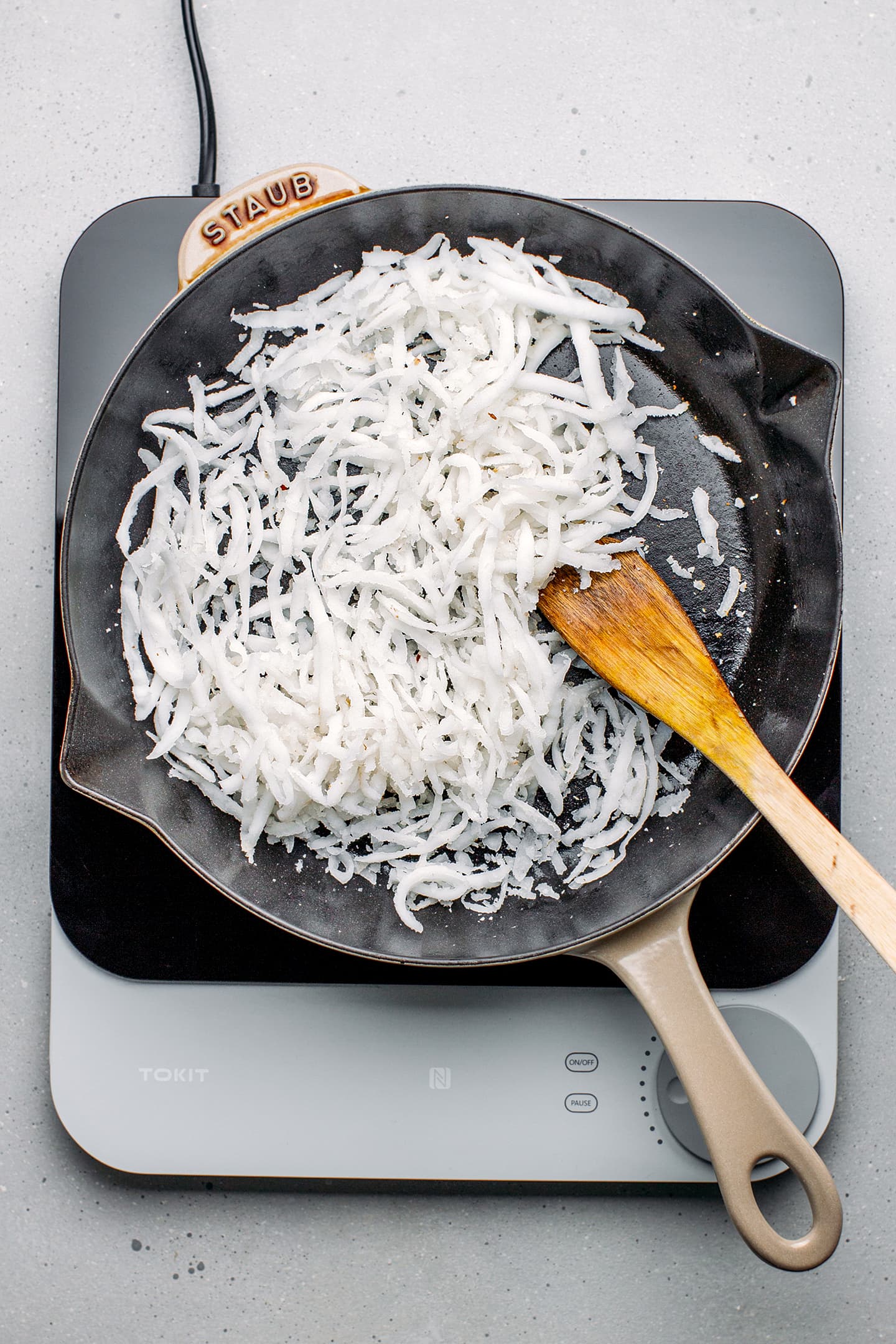
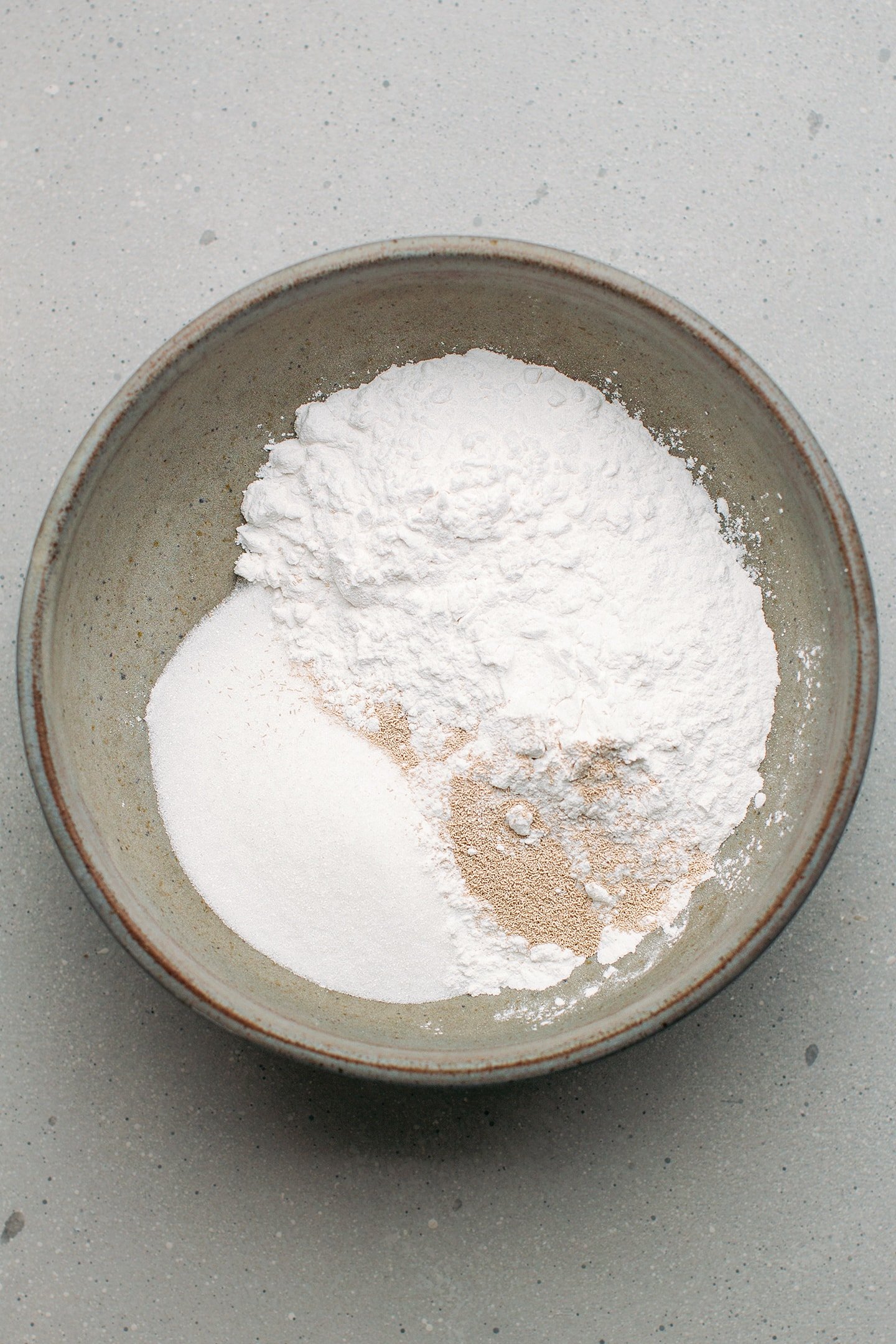
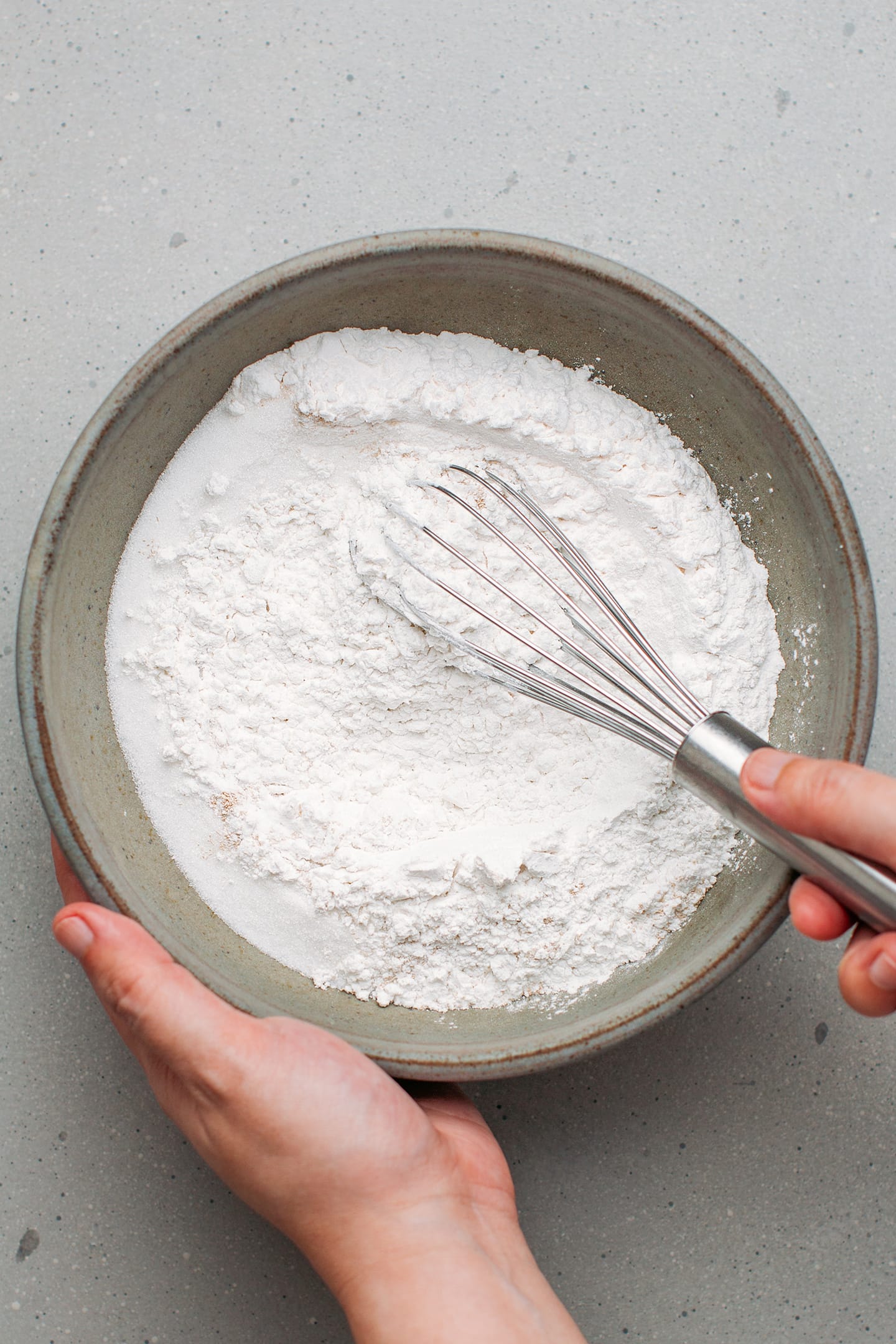

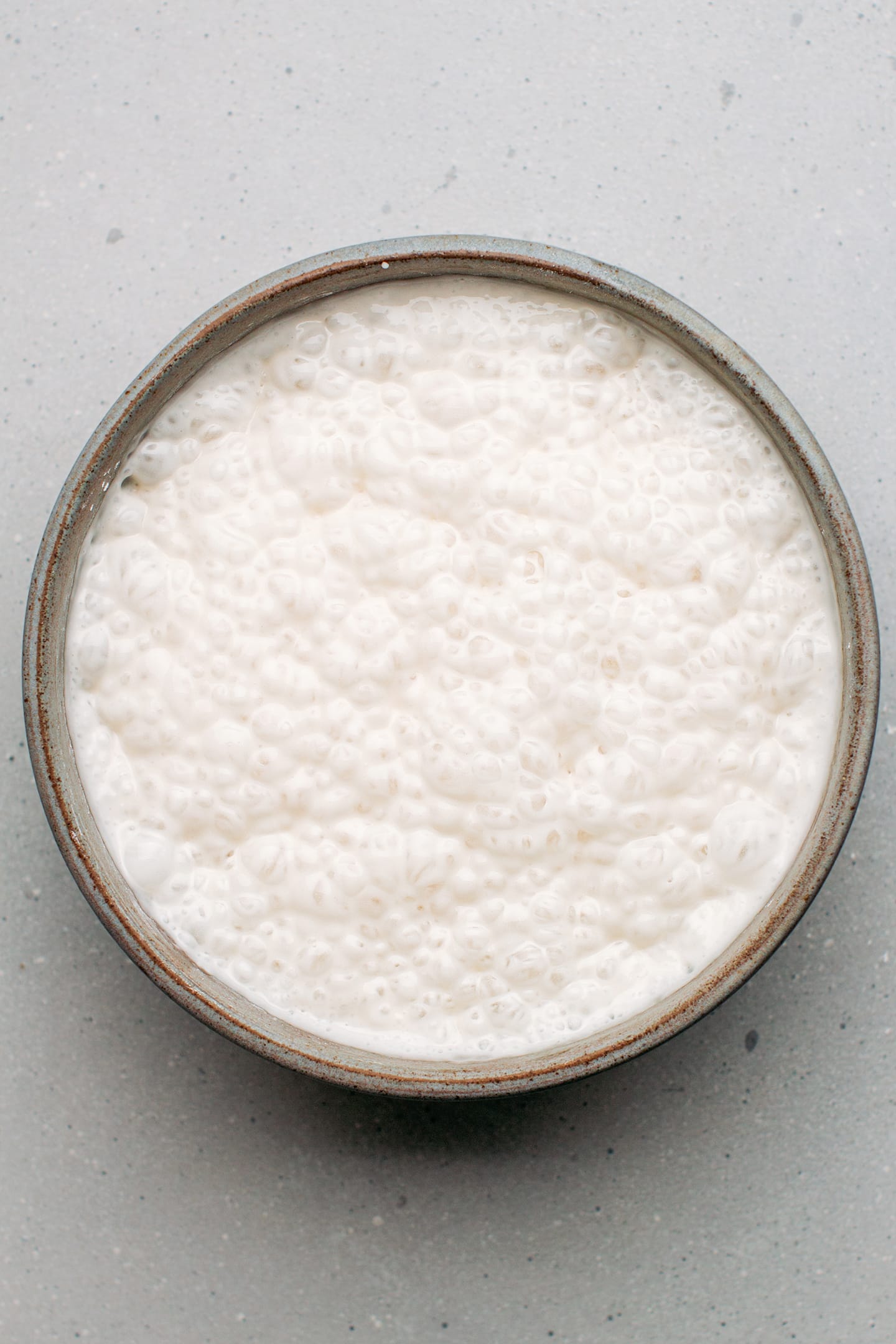
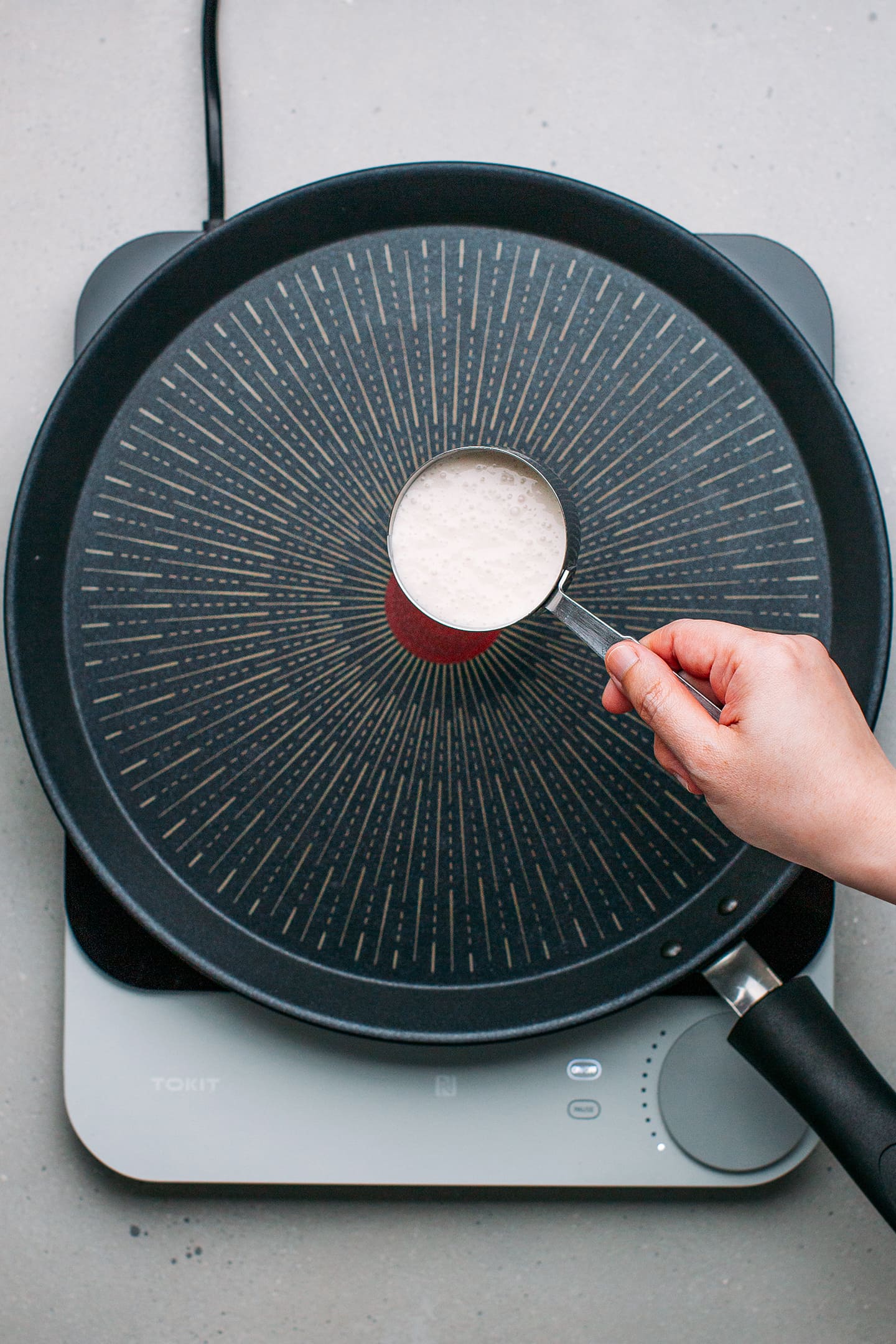




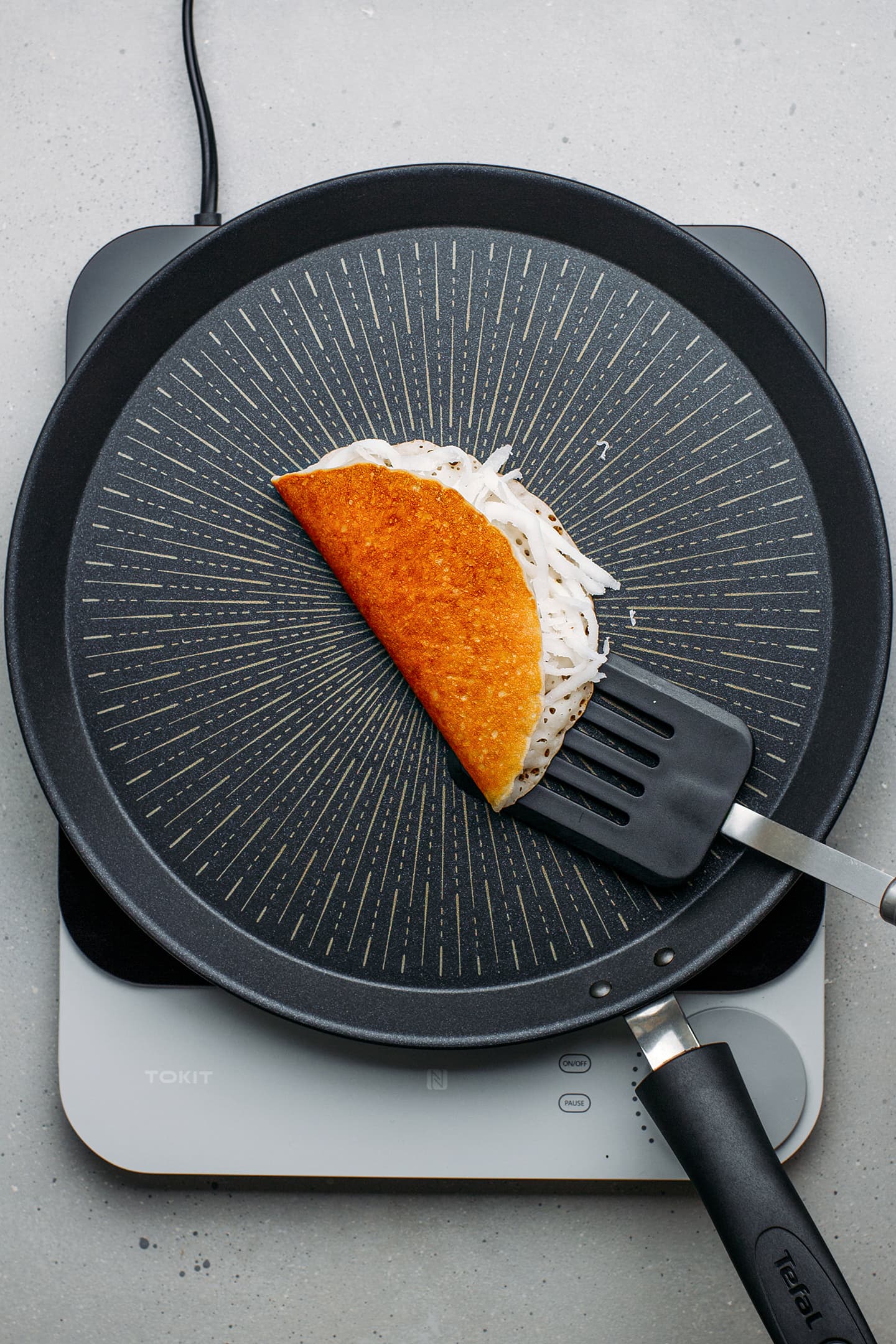





Leave a Comment
Just tried it for my family. Everyone loved it. Thank you Thomas.
Hey, these look amazing. Quick question. I don’t have access to fresh coconut. Can I use frozen grated coconut instead?